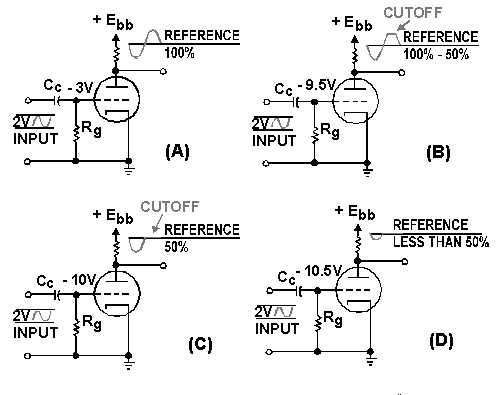1-37
Figure 1-27.—Classes of amplifier operation.
CLASS AB OPERATION
The Class AB amplifier is one in which the tube conducts for more than half, but less than the entire
input cycle.
View B of figure 1-27 depicts an amplifier biased into CLASS AB operation. Notice that in this
application, grid bias has been increased to -9 volts. We will assume that the tube reaches cutoff when the
voltage on the grid is -10 volts. Under these conditions, when the input reaches -10 volts, the tube will cut
off and stay cut off until the input goes above -10 volts. The tube conducts during the entire duration of
the positive alternation and part of the negative alternation. If you remember back in the discussion of
distortion, we pointed out that this represents distortion. In some amplifiers, faithful reproduction of the
input is not an important requirement. Class AB amplifiers are used only where this distortion can be
tolerated.
CLASS B OPERATION
A CLASS B biased amplifier is one in which the tube will conduct for only half of the input signal
duration. This is done by simply biasing the amplifier at cutoff. View C of figure 1-27 depicts a class B
biased amplifier.
As you can see, the tube conducts on the positive alternations. As soon as the input signal voltage
reaches 0 volts, the tube cuts off. The tube will remain cut off until the input signal voltage climbs above
zero volts on the next positive alternation. Because the tube conducts during the entire positive
alternation, but not on the negative alternation, the tube conducts for only half the input cycle duration.

